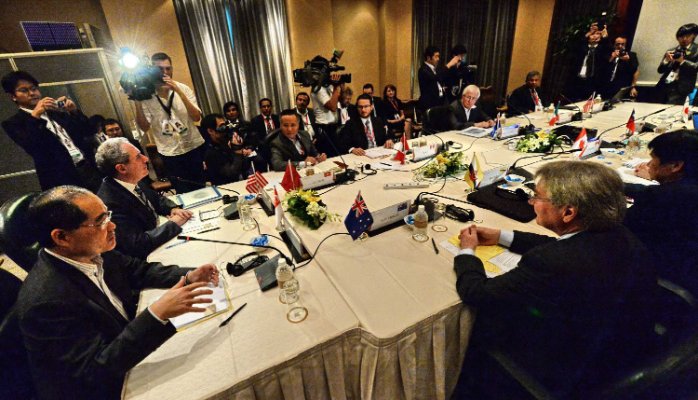Trade negotiators from the U.S., Australia, Brunei, Chile, New Zealand, Peru, Singapore and Vietnam met in March in Melbourne, Australia for the first round of talks. A second meeting was held in San Francisco in June. The Trans-Pacific Partnership is currently an agreement among Brunei, Chile, New Zealand and Singapore with a goal of removing all tariffs by 2015. It is a comprehensive free trade agreement (FTA)covering goods, services, sanitary and phytosanitary measures, rules of origin and intellectual property rights. President Obama on a trip to Asia late last year announced that the U.S. would enter negotiations in March of 2010. The U.S. currently has FTAswith Australia, Chile, Peru and Singapore.
One criticism of U.S. involvement in the talks is that the eightpartners have small economies. On a purchasing power parity(PPP) basis compared to the U.S. at $14.1 trillion in 2009,Australia’s economy is the world’s 17th largest with a annual GDP of $850 billion, followed by Vietnam, Peru, Singapore and Chile each at about $250 billion per year and ranked in 41-46th. Malaysia is the 29th largest economy at $380 billion. U.S. exports of goods and services to Malaysia were $10 billion in 2009. U.S. agricultural exports were $722 million, with soybeans and products at $234 million and fruits and vegetables at $97 million. The Minister of International Trade and Industryestimates that tariffs would be eliminated on 12.4 per cent of Malaysia's exports and 71.2 per cent of Malaysia's trade would have preferential tariff treatment. Malaysia has also begun talks with the EU on a trade agreement.
Japan’s potential involvement in the talks adds a totally new dimension. On a PPP basis Japan’s economy is the third largest country at $4.2 trillion in 2009. It was the number four exporter at $540 billion and number five importer at $500 billion. Japan was the fourth largest agricultural importer from the U.S. in fiscal year 2010 at $11.2 billion, with a forecast of $11.5 billion in 2011. Japan has been actively engaged in the WTO trade policy negotiations, but has lagged behind in FTAs. Among TPP countries, Japan has agreements with Brunei, Chile, Malaysia and Singapore and has had negotiations with Australia and Peru.
Japan’s reason for limited FTAs can be described in one word: agriculture. The country’s agricultural lobby has opposed further opening markets. According to Ministry of Agriculture, Food and Fisheries estimates for 2008 as reported by the U.S. AgriculturalAttaché in Japan, its overall caloric food self sufficiency is 41percent. Individual food category self sufficiency ranges from 96 percent for eggs, 95 percent for rice, 80 percent for vegetables, 70 percent for milk and dairy products, 56 percent for meats, 41 percent for fruit, 26 percent for feed grains, 14 percent for wheat and 6 percent for soybeans. These percentages have been stable for the last ten years. The Foreign Minister has said the government will focus on diversifying sources of food to avoid relying on a few suppliers. Japanese consumers are sensitive to quality, availability and price issues on food and will be carefullywatching any trade negotiations.
The agricultural trade policy issues in TPP cannot be ignored with exporters like the U.S., Australia, New Zealand, Chile and Malaysia at the negotiating table. The original goal of eliminating tariffs by 2015 would need to be rethought, not just stretched out for a few years. If a durable arrangement on agricultural trade could be worked out in the TPP trade talks with Japan, it would fundamentally change agricultural negotiations in the WTO and for existing FTAs.
The first country impacted could be South Korea, which has been mentioned as a possible partner in the TPP. It has similar agricultural policies as Japan in trying to protect a traditional agriculture in the midst of a growing urban economy built around trade. Its economy is the world’s 12th largest at $1.4 trillion in 2009, about the same as Mexico, with exports of $370 billion, the eighth largest, and imports of $320 billion, eleventh largest. South Korea is U.S. agriculture’s 6th largest export market at $5.0 billion in 2010 with the same projected for 2011. Farmers and consumers are as equally aware of trade policy as their Japanese counterparts.
If Japan and South Korea become part of the TPP, Canada and Mexico would probably follow because many of the lingering problems they have with the TPP countries would now be open to discussion. The target deadline for completing the agreement in time for the November 2011 Asia-Pacific Economic Cooperation(APEC) forum in Hawaii would likely slip as would any hope of free trade by 2015. The benefit would be a possible FTA across awide group of countries that would achieve the “high standard agreement” President Obama talked about a year ago and drive reconsideration of global trade policies, including the WTO Doha Round.
Regardless of what happens next in adding countries to the TPP deliberations, a fourth round of talks is schedule for December in New Zealand and freer trade is on the policy agenda throughout Asia. The Philippines has expressed interest in joining the talks. The Japanese government sees trade as a way to revitalize an economy burdened by large government debt and an agingpopulation and is pursuing trade talks with India. South Korea is ready to implement its new agreement with the EU. China and the Association of Southeast Asian Nations have begun implementing a tariff reduction agreement, and China has talked of a FTA with both South Korea and Japan. The leaders of the 21 nations of APEC, including the U.S., China and Russia, meet next month in Yokohama, Japan where more progress could be announced.

